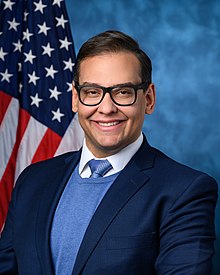Rainbow wave
The "rainbow wave" was a phrase coined in 2018[1] to describe the unparalleled number of openly LGBTQ+ candidates running for political office in the United States that year.
[1][4] The following year, in the 2019 elections, 382 openly LGBTQ+ candidates ran for public office and 200 made it on the ballot,[5] of which 170 won.
The 2015 Supreme Court case Obergefell v. Hodges solidified the constitutional right to same-sex marriage.
[19] Regarding the impacts of these candidates, LGBTQ+ representation in political office has been found to correlate strongly with the proposal and passage of pro-LGBTQ and equal rights legislation.
It has also been found to positively influence societal perceptions of the LGBTQ+ community and their equal rights at large.
[23] During this cycle, alongside the election of the first two openly gay politicians,[24][25] the first anti-homosexual measure was put on a ballot.
The measure was passed in Colorado through referendum, removing sexual orientation as a protected category from discrimination in Boulder's Human Rights Ordinance.
In the 1970s, LGBTQ+ political considerations focused on adding sexual orientation as a protected category to anti-discrimination ordinances.
In the 1980s and 1990s, the anti-LGBTQ+ movement intensified, most prominently through proposed amendments that would repeal and ban the anti-discrimination ordinances protecting lesbian, gay and bisexual people.
[26] According to the ACLU, there are over 450 anti-LGBTQ+ bills in the United States for the 2023 legislative session, targeting issues such as gender-affirming healthcare, gender identity and sexuality in public school education.
[27] A PBS News Hour, NPR, and Marist Poll showed increasing support for these anti-LGBTQ+ laws.
[26] For example, since 2021, there has been a 15% increase (from 28% to 43% of Americans) in support of laws banning gender-affirming medical care for minors.
[28]Drag queen and activist José Sarria became the first openly gay person to run for public office in the United States when he ran for the San Francisco Board of Supervisors in 1961.
[29] Kathy Kozachenko was elected to the Ann Arbor, Michigan City Council in 1974, becoming the first openly gay and lesbian politician in the United States.
[34] Danica Roem ultimately became the first openly-transgender state legislator when she was elected to the Virginia House of Delegates in 2017.
[38] A 2021 study by political scientists Gabriele Magni and Andrew Reynolds investigated voter attitudes towards a candidate based on their sexual orientation and gender identity in advanced democracies.
They found that the United States had the greatest voter penalties towards LGBT candidates of the three countries investigated (U.S., UK, and New Zealand).
The researchers conducted surveys through a conjoint experiment of over 1,800 Americans to measure their attitudes toward candidate characteristics in a hypothetical election.
[39] The study found that there is a wide variation in attitudes towards LGBT candidates based on different voter demographics.
Partisanship was a clear indicator, as the penalty for gay candidates between Republican and Democratic voters differed by 8.4 percentage points.
[39] The term "rainbow wave" was coined in the 2018 midterms,[1] as a result of the unprecedented number of candidates and elects.
[4] Twenty-two openly LGBTQ+ candidates ran for party seats in Congress, representing an increase of 340% since 2010.
[56][57] LGBTQ Victory Fund data from November 6, 2019, found that of these 382 candidates, 40% were from states that ranked at low or negative equality levels, of which 35.5% won.
[56] The Victory Fund endorsed 178 candidates of which 117 won: five in state legislatures, nine mayors, 102 local officials, and one judicial elect.
[56] Among other progressions in LGBTQ+ representation in 2019, the number of lesbian mayors in major cities doubled, as three were elected (in Chicago, Illinois; Tampa, Florida; and Madison, Wisconsin).
[68] In the 2021 rainbow wave, 430 openly LGBTQ+ candidates ran for public office of which 237 made the ballot and 184 won.
[106] A 2013 study by Andrew Reynolds investigated the effect of lesbian, gay, bisexual, and transgender elected officials on equal rights legislation regarding sexual orientation across 96 countries, not including the United States.
It found that even one LGBT elected official positively influences gay rights laws.
[106] A 2007 study by Donald Haider-Markel similarly examined the effect of LGBT elected officials on pro and anti-LGBT legislation in the United States between 1992 and 2002.
[107] A 1996 study by Kenneth Wald, James Button, and Barbara Rienzo found that the presence of openly gay candidates for public office in U.S. cities and counties increased the likelihood that the locality adopted and maintained a local gay rights and anti-discrimination ordinance.




